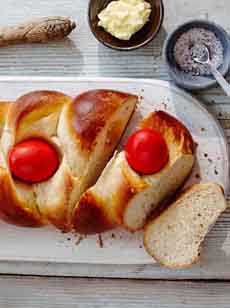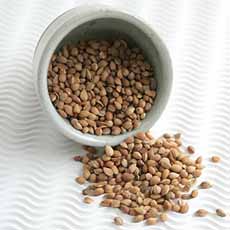FOOD 101: Mahlepi or Mahleb, A Middle Eastern Spice
|
We would never have heard of mahlepi or mahleb*, a Middle Eastern spice, were it not for Greek tsoureki (photo #1), one of our favorite Easter breads. Tsoureki, a soft, sweet and buttery braided yeast loaf, is famous for its embedded Easter eggs. We’ve never made it because it’s a two-day process, and we never have enough room in the fridge to let the loaf rise overnight. But if you’re game, here’s a recipe from King Arthur Flour. The traditional flavoring for tsoureki is a spice called mahlepi/mahleb. Most American bakers substitute vanilla, but for a deliciously authentic flavor, buy the real deal online. Mahleb adds a unique cherry-bitter almond, sweet-nutty flavor that will delight lovers of marzipan. You may like it so much, you’ll start adding mahlepi to butter cookies, muffins, pound cakes, scones and other baked goods and yeast breads. Mahleb is an aromatic spice that has been used for centuries† in the Middle East. It is made from the seeds of a particular species of cherry tree called the Mahaleb or St. Lucie cherry (Prunus mahaleb). The cherry stones are cracked to extract the seed kernel, which is ground to a powder. In addition to baked goods and other sweet foods, mahleb is in tresse cheese (jibneh mshallaleh, a string cheese from Syria. scones. In Egypt, powdered mahlab is made into a paste with honey, sesame seeds and nuts, eaten as a dessert or a snack with bread. In Greek cooking, beyond Easter bread it is used to flavor Christmas cake and pastries and eggy yeast cakes and cookies for the New Year, such as vasilopita (which contains a hidden coin or trinket that gives good luck to the recipient, like the Western king cake). In Egypt, mahlab is made into a paste with honey, sesame seeds and nuts, and eaten as a dessert or a snack with bread. |
 [1] Greek tsoureki bread, flavored with mahleb spice (photo courtesy King Arthur Flour).
|
|
|
For other recipes, mahleb pairs well when mixed with anise, black cumin (Nigella sativa) or caraway. Look for it in Greek or Middle Eastern markets, or online. *The spelling in English varies based on transliteration: mahlab, mahalab, mahlep, mahaleb, etc. In Greece, it is mahlepi. †Recipes for a seed that may be mahleb have been found in records from ancient Sumer.
|
||



